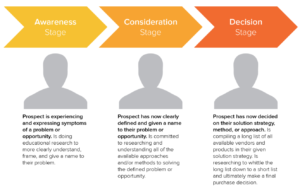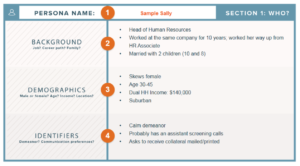Are you getting tired of hearing digital marketers throw around the phrase “buyer’s journey”? It’s true – the concept has become something of a fad in marketing circles.
But that doesn’t mean that it’s not a powerful framework that can help you understand your marketing. In fact, business owners that know what the buyer’s journey is are often much more skilled at finding a great marketing agency to help them.
So whether you plan to DIY your digital marketing or outsource it to a marketing agency, here’s a quick guide on what the buyer’s journey is and how you can track it for maximum ROI.
What is The Buyer’s Journey?
The Buyer’s Journey is a method for organizing your marketing channels and unifying them around empowering the customer toward a purchasing decision.
While the current framework is a fairly recent idea popularized by Hubspot Academy (and its marketing automation software), the underlying principles are not new. Decades ago, marketing students would have learned concepts like Maslow’s Hierarchy of Needs and even hints of the marketing funnel.
That said, The Buyer’s Journey is made possible by the growing volume of consumer behavior data available from years of Internet and social media use. Search engines and content aggregators (i.e., social media platforms) track every user action online.
In time, analysts and marketers have determined clear paths that buyers take from the moment they figure that they have a problem, to their final purchasing decisions. Using hard data, experts are further able to notice when buyers buy with more or less confidence.
That’s why The Buyer’s Journey has become so critical in recent years. By understanding and abiding by these concepts, businesses can not just increase their sales, but they can also lower buyer anxiety along the way and reduce buyer’s remorse. The result is that buyers become loyal customers and feel empowered (rather than coerced into) their purchasing decisions.
Hubspot and the Popularization of The Buyer’s Journey
Hubspot is a marketing automation company credited with some of the finest free training on inbound sales and marketing. Many of their Hubspot Academy courses are great for novices and professionals alike.
A key component to their inbound marketing training revolves around The Buyer’s Journey as represented in the infographic below.

The three stages to The Buyer’s Journey are as follows:
-
- Awareness stage: A buyer is trying to wrap words around their problem. They consult search engines and forums to better understand their problem and possible solutions.
- Consideration stage: The buyer understands basic terminology and is starting to shop and compare all available solutions.
- Decision stage: The buyer feels confident enough to finalize a purchase with the hopes that that purchase will help them solve their problem.
Amid the discussion about The Buyer’s Journey, Hubspot Academy (and any marketing expert worth their salt) challenges the business owner to learn more about their target audience. At the end of the day, your knowledge about your target audience dictates how well you understand their Buyer’s Journey.
What is a Buyer Persona?
Hubspot Academy also popularized the exercise of creating Buyer Personas. Buyer Personas are ideal customer profiles that detail everything you know about your target audience.

Typically, business owners and marketers create a Buyer Persona representative of each market segment. From those Buyer Personas, one can visualize a customer Buyer’s Journey and begin to construct a marketing strategy to empower customers toward a purchasing decision.
How Do You Track the Buyer’s Journey?
Putting your customer knowledge to the test is a critical part of any marketing strategy. Tracking your customer Buyer’s Journey allows you to improve your marketing and sales approach over time.
Thanks to today’s marketing analytics tools, you have more data than you could ever hope to organize and understand. That’s why it’s ideal that you work with a digital marketing professional to help you make sense of the data.
But there are a few high-level metrics that will help you track your customer Buyer’s Journey.
Metrics for the Awareness Stage
During the awareness stage, your marketing should exist to help people wrap words around their problem. That means that you’re delivering helpful information via your owned media channels (i.e., your website, email newsletters, social media, etc.).
Key metrics for tracking prospects in the awareness stage are:
- Page views
- Page session duration
- Link clicks (CTRs)
Metrics for the Consideration Stage
In the consideration stage, you’re trying to help your audience size up your industry and understand what constitutes a quality solution to their problem. Over time, you hope to convince prospects that you are the best solution. But to do that well, you need to continue to deliver value and guidance.
Key metrics for tracking prospects in the consideration stage are:
- eGuide downloads
- Requests for more information
- Demo requests
- Link clicks (CTRs)
Metrics for the Decision Stage
The final stage naturally results in a sale. Your decision stage key metrics are:
- Subscriptions/sign-ups
- Revenue
- Conversions
In Conclusion – How the Buyer’s Journey Can Help Your Business
A short-sighted sales and marketing business model can only see point-of-sale moments. Dollars invested into this model are usually ad heavy and intrusive, because the goal is to close and rarely to guide customers toward a well-planned purchasing decision.
A mature, sustainable approach to marketing and sales requires businesses to help their customers by providing information, answering questions, and customizing a solution for them. Achieving this means better understanding the journey that that customer takes to get to the moment that they feel empowered to make a purchasing decision.
The Buyer’s Journey is a great model for businesses to connect with customers and improve their sales/marketing process.
